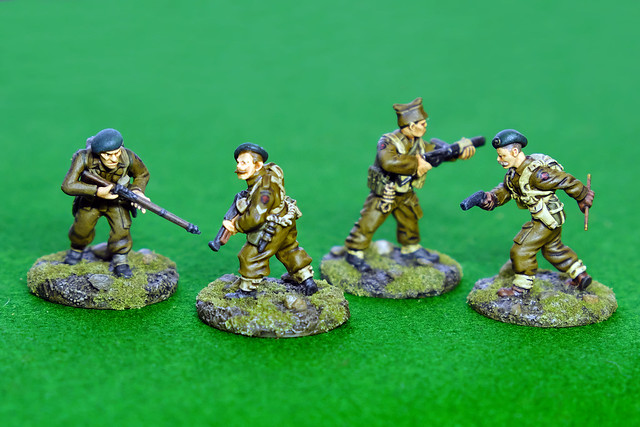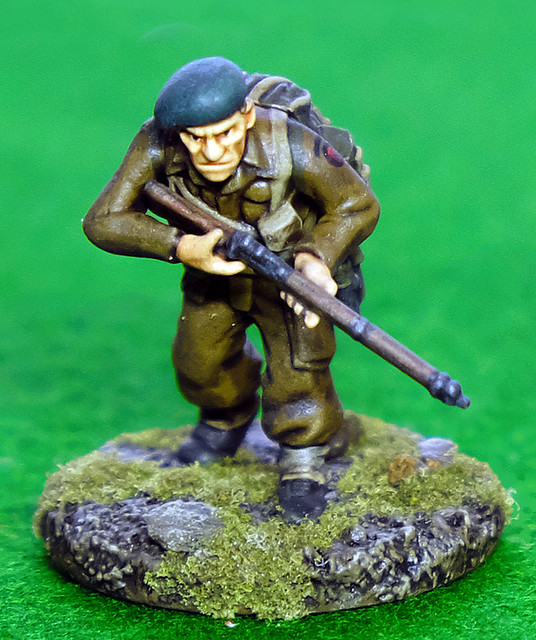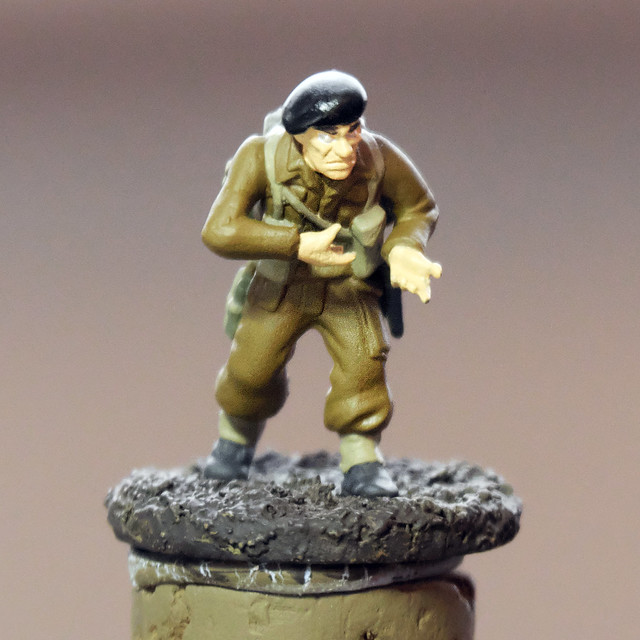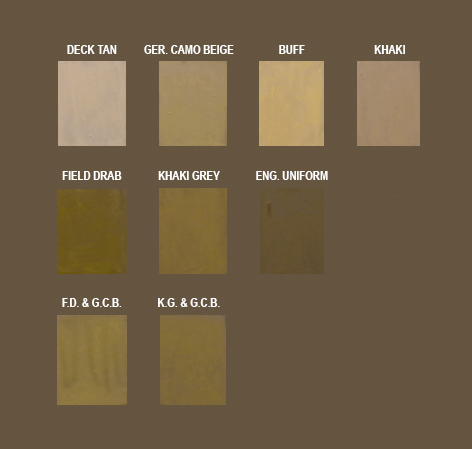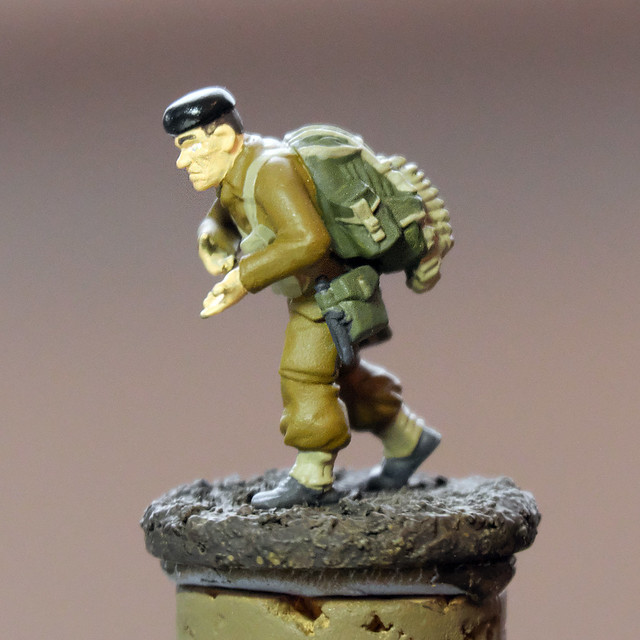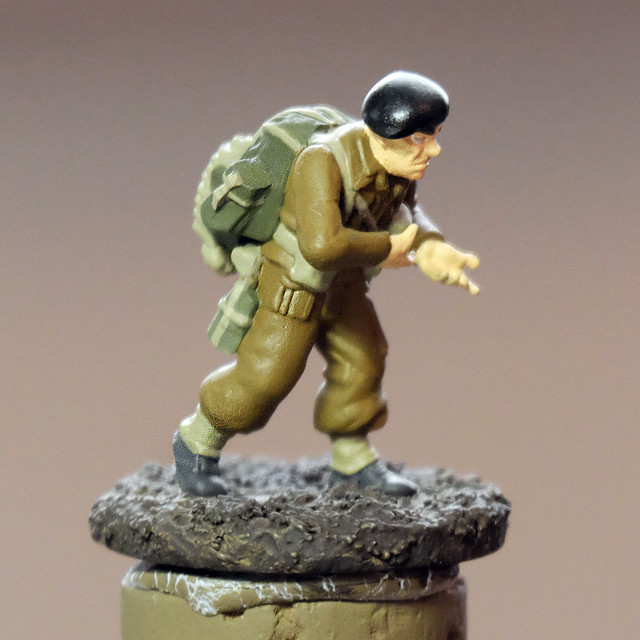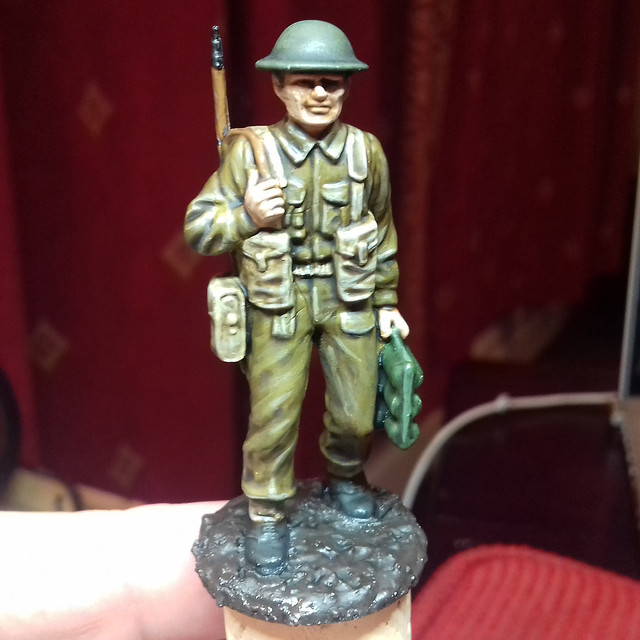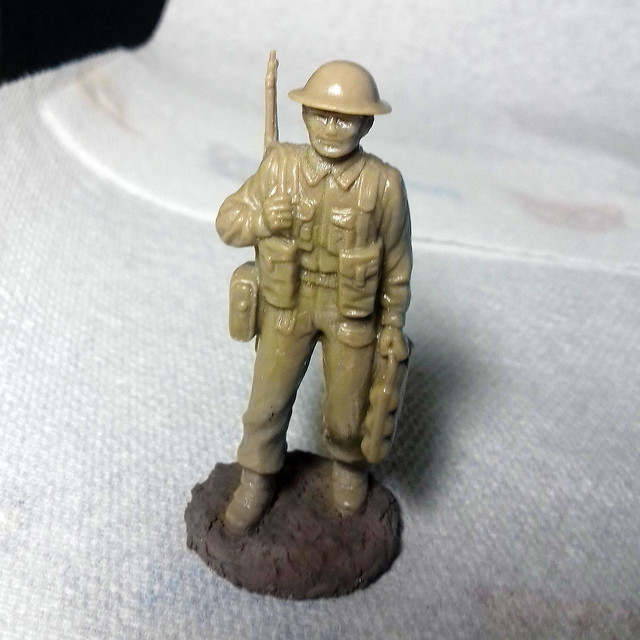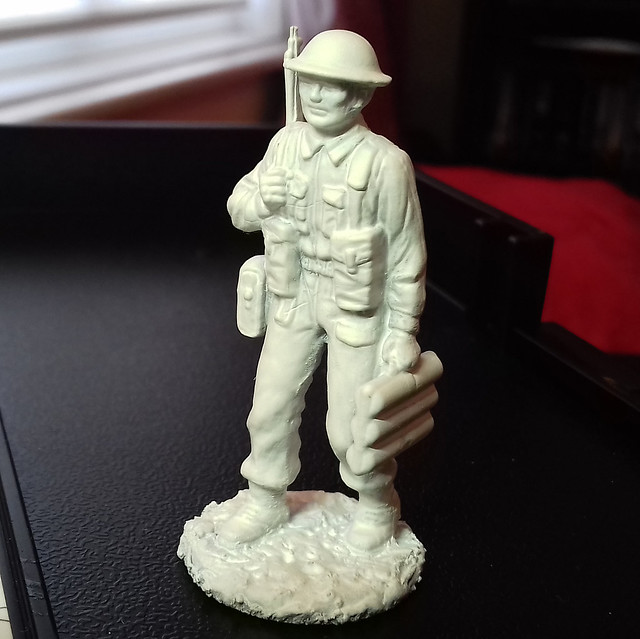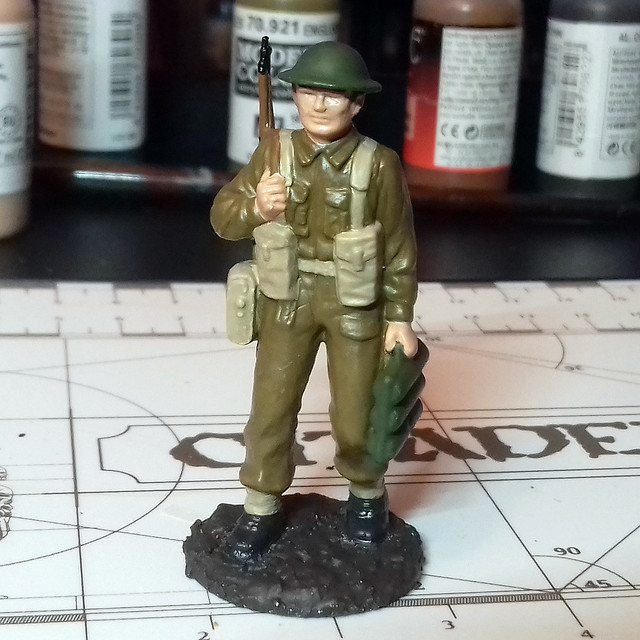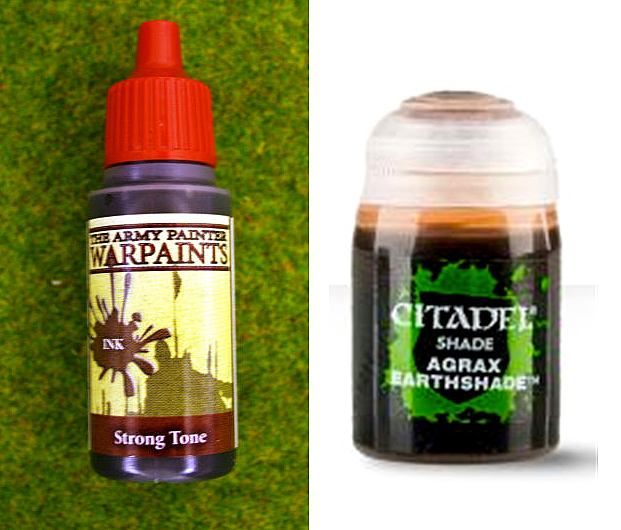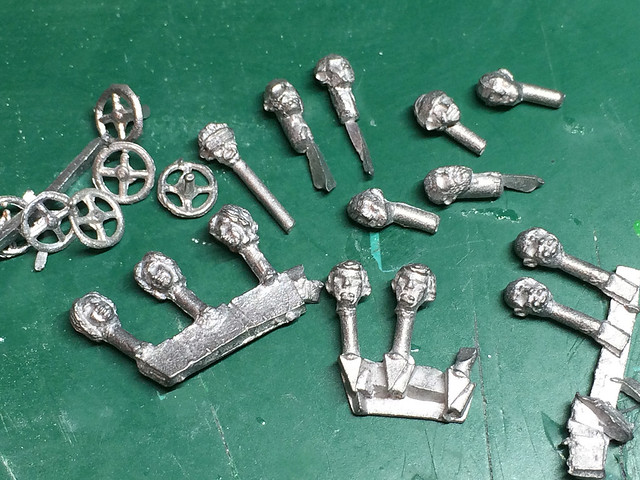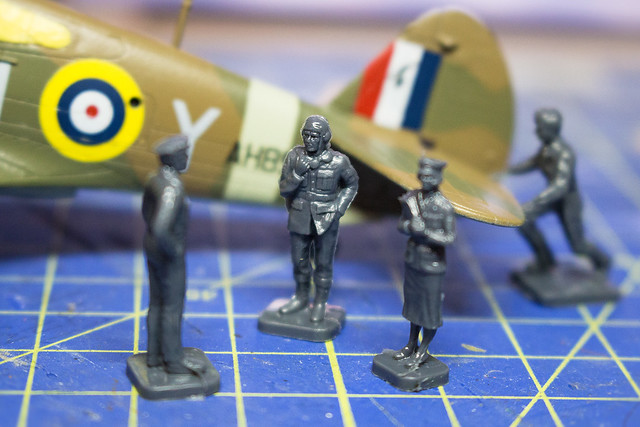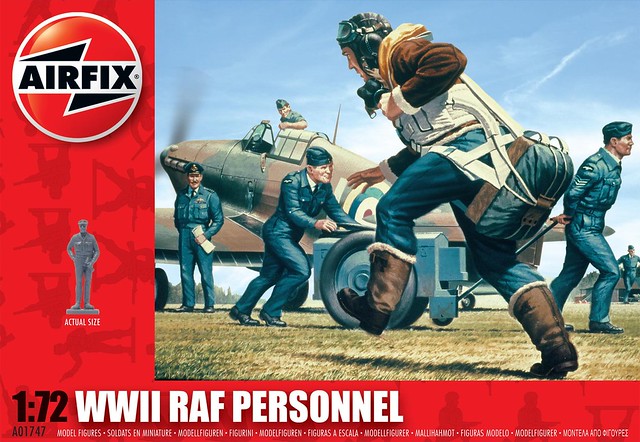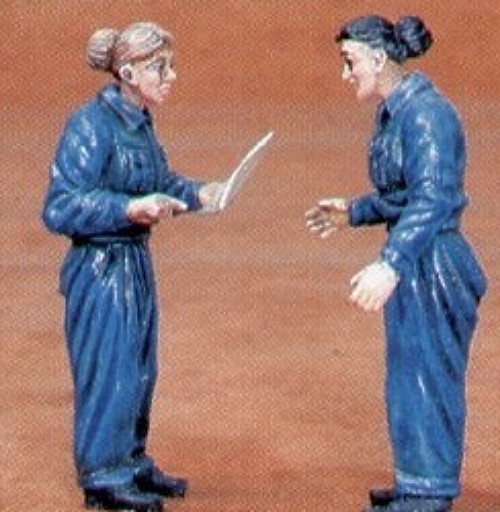Finished the initial test figures...
Well, about time I finished something! Because these were my first experiments with 28mm figure painting it took a bit longer than I expected, mainly because I changed my mind about my colours a few times.
Like I said in an earlier post, the colours aren't exactly historically accurate. Rather, I have modified the colour palette used to suit tabletop gaming (so the contrast and lightness is somewhat exaggerated). Having said that, I am quite pleased for my first attempt.
That done, now the real work begins...I shall be starting to put together my first Bolt Action Commando platoon!
Diary of a novice scale model maker and his adventures in the wacky world of Braille Scale.
Showing posts with label figures. Show all posts
Showing posts with label figures. Show all posts
Sunday, 19 March 2017
Tuesday, 14 March 2017
Commando Figures - Basing
The whole purpose of doing this blog was supposed to be so I could document techniques and processes so I could come back later and remind myself how I did 'something'. Annoyingly, I didn't do this for my figure basing process so I am having to remind myself - again - how I did it the first time!
5. Rocks and stones: I'm not too fond of the fake 'flowers' that seem to be in fashion as base ornamentation at the moment. I prefer to keep things simple, just some 'moss' (or grass) and some random 'rocks'. I super glue some tiny pebbles I find in the back yard onto the bases. [Note: I may do this stage while laying down the Pollyfilla/Lava material so that the stones stick in the 'ground' instead of being glued on top of it.]
6. First High-Lights: I then start my highlight dry-brushing, with - first - a medium brown (Burnt Umber mixed with Khaki) and then I dry-brush a very light highlight on top of Khaki.
And, there we go. The figure is now ready to have the shoulder patch decals applied and then fixed in place with a final coat of matt varnish. This will also take the shine off the model.
Conclusion...
I did notice that while this worked perfectly well for my smaller 1/72 war game figures, I think I need to add a little more texture to the larger 28mm scale disc base. In retrospect, this is probably why many modellers add 'flowers' and tall grass clumps to their bases.
I am still a bit adverse to flowers but will experiment with other texture additions in future figures.
 |
| Above: One of my current (1/56) figures next to one of the (1/72) Germans that I completed last year. I like the way I did the base, but I forgot to document just how I did it! |
After some examination of figures I had previously done I think I have a rough idea of the 'recipe'...
[Bear in mind that I don't create the base in isolation, I work on it as I paint the figure itself. It's not done in one go, but over a period of time finishing after the painting of the figure is completed.]
[Bear in mind that I don't create the base in isolation, I work on it as I paint the figure itself. It's not done in one go, but over a period of time finishing after the painting of the figure is completed.]
1. Base: The foundation of the 28mm base is a 25mm diameter disc, though - as I mentioned in a previous post - I like to base my Bolt Action figures on metal discs (in this case, 25mm steel repair washers).
2. Ground Effect: Next I build up the 'ground' with a rough application of quick drying PollyFilla. This I either mix with some dark brown paint or with Vallejo's 'Black Lava' compound so that the PolyFilla plaster is no longer white.
3. Base Colour: Once dry, I slap on some Vallejo Black Brown as my earth base layer.
4. Wash: Then I apply a black wash to pick out the nooks and crannies.
5. Rocks and stones: I'm not too fond of the fake 'flowers' that seem to be in fashion as base ornamentation at the moment. I prefer to keep things simple, just some 'moss' (or grass) and some random 'rocks'. I super glue some tiny pebbles I find in the back yard onto the bases. [Note: I may do this stage while laying down the Pollyfilla/Lava material so that the stones stick in the 'ground' instead of being glued on top of it.]
6. First High-Lights: I then start my highlight dry-brushing, with - first - a medium brown (Burnt Umber mixed with Khaki) and then I dry-brush a very light highlight on top of Khaki.
7. Grass: I don't bother with fancy static grass, just plain old flock from my local railway model shop (the cheapest mid-green colour). I like a bit of 'earth' showing through...
8. Finishing Highlighting: As it is the grassy base is still a little flat and bland, so I then go in and do some extra highlighting and colouring just to pick it up a little. I did some gentle dry-brushing with Vallejo's Stone Grey and then added some spots of Citadel's Agrax Earthshade wash here and there for some extra depth or where I thought my 'ground' was becoming too light (the idea is to create contrast).
I also very lightly dabbed some spots of Vallejo Stone Grey onto the flock 'grass' to add some areas of bleached grass. Just for some variety in colour.
I also very lightly dabbed some spots of Vallejo Stone Grey onto the flock 'grass' to add some areas of bleached grass. Just for some variety in colour.
9. Glossing: Although this stage is actually to provide the paintwork with some protection and prepare the model for the addition of decals, a coat of varnish also helps to stick down that pesky flocking (which has a tendency to moult if you aren't fastidious with your glueing)!
Conclusion...
I did notice that while this worked perfectly well for my smaller 1/72 war game figures, I think I need to add a little more texture to the larger 28mm scale disc base. In retrospect, this is probably why many modellers add 'flowers' and tall grass clumps to their bases.
I am still a bit adverse to flowers but will experiment with other texture additions in future figures.
Tuesday, 7 March 2017
Bolt Action British Commandos Part 6
Just some minor progress as I continue to experiment with my 28mm test figures. I'm slowly feeling my way with the 'Bolt Action' style of painting - which has been described to me as 'heroic' (in the vein of 28mm fantasy figures) - and I think I'm getting somewhere...
It's slow progress as I have repainted certain parts a couple of times as I adjust and refine my colours. And I have finally come up with a palette that I am happy with. Ironically, it's not entirely historically authentic.
Drab World War 2 Uniforms being what they were (with good reason), the earthy tones tended to blend at a distance. This is not necessarily so attractive for a tabletop game where it's nice for your army to be easily identifiable and distinct from your opponent. So I have exaggerated contrasting colours a bit to make these figures something of a caricature of WW2 British Commandos.
Overall, I'm pleasantly surprised and pleased with my progress. 28mm is turning out to be a very nice compromise between the 1/72 and 1/32 scale figures that I have worked on before, a nice amount of detail but not too big a 'canvas' (1/32 does take quite a bit of paint)!
Things left to do:
• Finish base terrain (add grass and some 'rocks')
• Maybe add some highlights to faces and berets
• Gloss figures and apply shoulder decal badges
• Apply light matt varnish coat to flatten gloss coat
 |
| My four 'guinea pigs', brands from left to right - Artizan, Warlord, Black Tree & Dixons. |
Drab World War 2 Uniforms being what they were (with good reason), the earthy tones tended to blend at a distance. This is not necessarily so attractive for a tabletop game where it's nice for your army to be easily identifiable and distinct from your opponent. So I have exaggerated contrasting colours a bit to make these figures something of a caricature of WW2 British Commandos.
Overall, I'm pleasantly surprised and pleased with my progress. 28mm is turning out to be a very nice compromise between the 1/72 and 1/32 scale figures that I have worked on before, a nice amount of detail but not too big a 'canvas' (1/32 does take quite a bit of paint)!
Things left to do:
• Finish base terrain (add grass and some 'rocks')
• Maybe add some highlights to faces and berets
• Gloss figures and apply shoulder decal badges
• Apply light matt varnish coat to flatten gloss coat
Wednesday, 1 March 2017
Bolt Action British Commandos Part 4
Painting Tests of 28mm Figures - Base Colours
All the tinkering and cleaning up done, my two test figures are ready for priming. As an experiment, I decided to prime the figures using Humbrol's 'Dark Brown' Acrylic Spray...
All the tinkering and cleaning up done, my two test figures are ready for priming. As an experiment, I decided to prime the figures using Humbrol's 'Dark Brown' Acrylic Spray...
Normally I would use the normal priming colours of either black, white or grey but I was curious to see if using a colour more in harmony with the overall tones used in the figure would be advantageous. These British Commandos will be predominantly Brown/Khaki uniform and tan flesh tones so a mid/dark brown base seemed logical.
Aside from this change, I am using the same basic colour procedure/recipe that I used in my first 1/32 test figure. So, I will be starting with the uniform and Vallejo's 'English Uniform'. This is pretty much standard for many figure painting tutorials for these figures I have seen (though some suggest a browner mix) and I have gone with this in the hope it goes a little browner after a wash is applied (as with my painting test).
Webbing Woes...
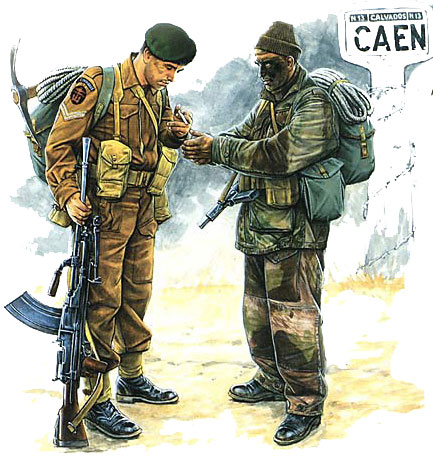 |
| Colour rendition on the web is all over the place, but I have decided to go with the above reference (left) for my British Commando uniform. Source: Unknown. |
Webbing Woes...
The webbing is *still* a bit of a quandary - do I do it early/mid-war khaki/beige or do I go for a later war khaki olive to represent webbing which has had 'Blanco' applied? In the end, I plumped for khaki as the majority of reference material showing Commandos I have found shows them with the khaki 1937 webbing set, even though the use of 'pea green' Blanco (a dye applied to the webbing) among some units became more widespread later in the war. But which colour to use for the khaki?
Here are some of my paint test swatches based on the Vallejo Model Color range of paints...
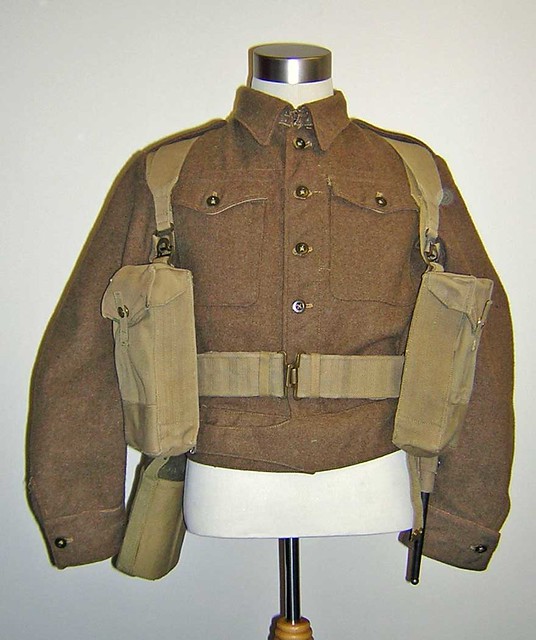 |
| Infantry Set, Battle Order, Late War, circa 1944-45. Source: www.karkeeweb.com |
A very unscientific comparison leads me to believe that - from my swatches - Ger. Camo Beige is the closest match to the photographic sample from Karkeeweb.
Resulting Base Painted Figure
The basecoat stage always looks nice and clean and flat (I'm a graphic designer so kinda like the unshaded 'cartoony' look to this stage), and the colours are a little bright at this point. But, this is just the preparatory stage before shading...
Vallejo Colours used:
• Uniform: Model Color 'English Uniform' [921]
• Webbing (Khaki): Model Color 'Ger. C. Beige WWII' [821]
• Bergan Backpack: Model Colour 'Cam. Olive Green' [894]
• Bergan Trim: 'Ger. C. Beige'
• Webbing Items (Olive): 50/50 mix of 'Ger. C. Beige' and 'Cam. Olive Green'
• Boots: Panzer Aces ' Dark Rubber' [306]
• Flesh: Model Color 'Flat Flesh' [955]
• Beret: Model Color 'Black' [950]
I've gone for a mid-colour flesh tone rather than starting with a darker base. We'll see how that works out. I'll be applying a shading wash, so didn't want to start too dark.
For the boots and other black items, I've started using 'Dark Rubber' (a dark, bluish-grey) as a base. Again, once a wash is applied (black) it will give a subtle shading effect.
Finally, I have begun with a flat black base for the beret. This, of course, will end up being the famous Royal Marine Commando green beret - but I want a dark undertone to the green, which I will then shade and highlight so that will turn out (hopefully) a deep rich forest green.
Next: The shading washes and highlighting.
Vallejo Colours used:
• Uniform: Model Color 'English Uniform' [921]
• Webbing (Khaki): Model Color 'Ger. C. Beige WWII' [821]
• Bergan Backpack: Model Colour 'Cam. Olive Green' [894]
• Bergan Trim: 'Ger. C. Beige'
• Webbing Items (Olive): 50/50 mix of 'Ger. C. Beige' and 'Cam. Olive Green'
• Boots: Panzer Aces ' Dark Rubber' [306]
• Flesh: Model Color 'Flat Flesh' [955]
• Beret: Model Color 'Black' [950]
I've gone for a mid-colour flesh tone rather than starting with a darker base. We'll see how that works out. I'll be applying a shading wash, so didn't want to start too dark.
For the boots and other black items, I've started using 'Dark Rubber' (a dark, bluish-grey) as a base. Again, once a wash is applied (black) it will give a subtle shading effect.
Finally, I have begun with a flat black base for the beret. This, of course, will end up being the famous Royal Marine Commando green beret - but I want a dark undertone to the green, which I will then shade and highlight so that will turn out (hopefully) a deep rich forest green.
Next: The shading washes and highlighting.
Thursday, 23 February 2017
Bolt Action British Commandos Part 3
Warlord 28mm British Commandos
I am pretty sold on the Artizan Commando miniatures (love the sculpting), but I want to do my next painting test on a figure of the correct scale, but then don't want to ruin one of the Artizen figures. So, I bought a sprue from Warlords range of 28mm plastic Commandos, it's handy that Warlord sell their sprues individually, but don't make the mistake I did and buy the figure sprue without also buying the weapons sprue! (I've had to wait a further few days until the weapons sprue arrived before I could get on with making my next test figure.)
Anyway, the postie brought the additional sprue I needed this morning, so let's have a look...
I can see why people like 28mm, after doing 1/72 the extra detail that can be squeezed into 1/56 is very welcome, without the models being significantly bigger (like 1/48 or 1/35). It's a very happy balance between what's good for tabletop gaming and visible interest, 1/72 (20mm) figures are a little less interesting at tabletop distance (but that's a matter of opinion).
Another difference between the 'serious' 1/72 models I have been doing and the gaming 28mm figures by Warlord is that these little chaps are full of fun, like little 3D caricatures or cartoons of soldiers. They have the look of characters straight out of the Commando comic or the Victor (if you are old enough to remember that). The poses are dynamic and somewhat over dramatic, but are completely in keeping with the fun nature of the Bolt Action game.
Metal or Plastic?
I suppose one of the questions that the Warlord sprues raise is, what is better, metal or plastic figures?
As I mentioned, I am smitten with Artizan's metal 28mm Commandos, but, of course, you get what poses you are given with them. Plus, there are a limited number of poses within Artizan's range. Therein is the disadvantage of metal miniatures.
Warlord's multipart plastic miniatures system allows a much greater variety of poses to be made, meaning that you need not repeat the same figure again in the same unit. You also have a greater ability to customise your figures and add specific weapon poses.
Artizen's miniature work out at about £1.45 a pop, and while buying Warlord's figures by the sprue - as I did - works out more expensive than metal figures, the real saving is made when you buy a plastic starter set. Warlord's Commandos starter set is £24 and includes enough sprues to make 25 figures (which works out at 96p per figure).
So, are there any downsides to plastic miniatures over metal?
Well, it may be a bit of a personal preference, but I think the extra weight of the metal figures is something of an attractive attribute over their plastic counterparts. I worry that plastic miniatures might break when handling as they just don't feel durable.
Another issue with plastic miniatures - in my opinion - is that the interchangeable limbs and separate weapons and accessories are a bit fiddly to put together. And they aren't as interchangeable as they first appear. When putting together my first figure I had to try out several arms until I found a combination that seemed to look natural and that fitted the rifle I wanted. (There are no instructions or a guide to assembly with the sprues or on the Warlord website.)
(Incidentally, I did a straw poll on the Bolt Action Facebook Group and the consensus was almost exactly 50/50 when asked whether members prefer metal or plastics.)
The Finished Figure...
After much messing around - and referring to a couple of other modeller's blogs - I managed to piece together my test Commando. In all, there were 9 pieces in this little kit (and no pilot holes or pegs, so much of the limbs and equipment just 'hangs' where you glue it)!
I am not entirely happy with Warlord's flimsy plastic weapons and I think I prefer the chunky one-piece metal ones. Being an integral part of the figure sculpture the metal weapons look less breakable.
Basing
Just a quick note on basing. To compensate for the exceedingly light-weight plastic figure I decided to use 25mm Steel Repair Washers as bases. These not only give the figures a little bit of heft, but can also be used in combination with magnetic sheets (in case you want to 'stick' a group of figures to a magnetic strip so you can move the figures as a unit).
Finally, I will be adding some ground effects by slapping on a thin layer of Pollyfilla (mixed with some of Vallejo's 'Black Lava', which has a nice gritty texture). This will not only give the figures an attractive terrain effect but will also disguise the different basing techniques.
Next: Priming the test models.
I am pretty sold on the Artizan Commando miniatures (love the sculpting), but I want to do my next painting test on a figure of the correct scale, but then don't want to ruin one of the Artizen figures. So, I bought a sprue from Warlords range of 28mm plastic Commandos, it's handy that Warlord sell their sprues individually, but don't make the mistake I did and buy the figure sprue without also buying the weapons sprue! (I've had to wait a further few days until the weapons sprue arrived before I could get on with making my next test figure.)
Anyway, the postie brought the additional sprue I needed this morning, so let's have a look...
 |
| The additional British Army weapons sprue (£4). |
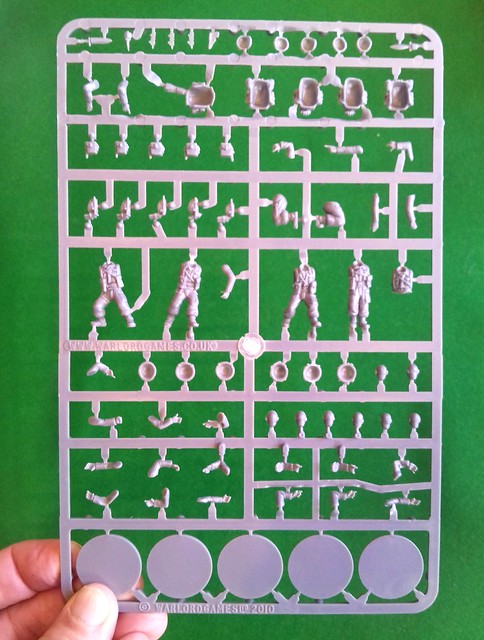 |
| Warlord's 28mm Commandos sprue (£6). There are enough parts to make 5 figures, 5 standing and 1 kneeling. |
 |
| Close-up on the Commandos figure sprue. |
Metal or Plastic?
I suppose one of the questions that the Warlord sprues raise is, what is better, metal or plastic figures?
As I mentioned, I am smitten with Artizan's metal 28mm Commandos, but, of course, you get what poses you are given with them. Plus, there are a limited number of poses within Artizan's range. Therein is the disadvantage of metal miniatures.
Warlord's multipart plastic miniatures system allows a much greater variety of poses to be made, meaning that you need not repeat the same figure again in the same unit. You also have a greater ability to customise your figures and add specific weapon poses.
Artizen's miniature work out at about £1.45 a pop, and while buying Warlord's figures by the sprue - as I did - works out more expensive than metal figures, the real saving is made when you buy a plastic starter set. Warlord's Commandos starter set is £24 and includes enough sprues to make 25 figures (which works out at 96p per figure).
So, are there any downsides to plastic miniatures over metal?
Well, it may be a bit of a personal preference, but I think the extra weight of the metal figures is something of an attractive attribute over their plastic counterparts. I worry that plastic miniatures might break when handling as they just don't feel durable.
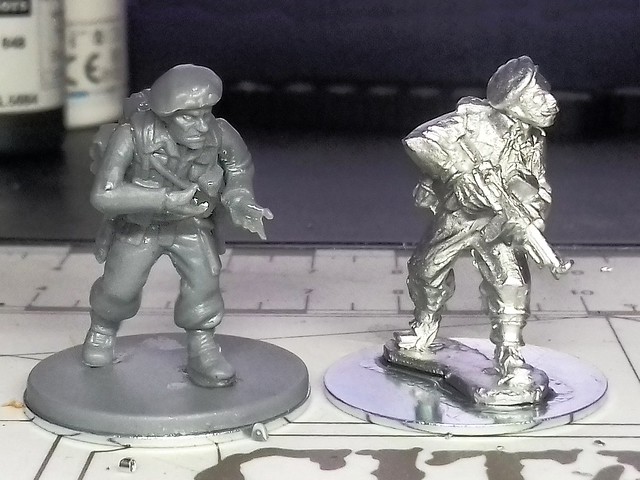 |
| Left: A Warlord multipart plastic 28mm Commando (minus weapon, as I have been advised to paint them separately). Right: An Artizan one-piece metal Commando. |
 |
| Equipment comparison between Warlord plastic and Artizan metal figures. The poor old Warlord Commando is very heavily laden! |
The Finished Figure...
After much messing around - and referring to a couple of other modeller's blogs - I managed to piece together my test Commando. In all, there were 9 pieces in this little kit (and no pilot holes or pegs, so much of the limbs and equipment just 'hangs' where you glue it)!
I am not entirely happy with Warlord's flimsy plastic weapons and I think I prefer the chunky one-piece metal ones. Being an integral part of the figure sculpture the metal weapons look less breakable.
Basing
Just a quick note on basing. To compensate for the exceedingly light-weight plastic figure I decided to use 25mm Steel Repair Washers as bases. These not only give the figures a little bit of heft, but can also be used in combination with magnetic sheets (in case you want to 'stick' a group of figures to a magnetic strip so you can move the figures as a unit).
Finally, I will be adding some ground effects by slapping on a thin layer of Pollyfilla (mixed with some of Vallejo's 'Black Lava', which has a nice gritty texture). This will not only give the figures an attractive terrain effect but will also disguise the different basing techniques.
Next: Priming the test models.
Wednesday, 15 February 2017
Bolt Action British Commandos Part 2
The results of my first paint test for this project allowed me to work out which colours I am going to use for my 28mm British figures...
I have some tweaking to do, but I want to try any further tests on an actual 28mm figure instead of another 1/32 plastic soldier. The scale of the brushwork for this sort of painting means it doesn't exactly work on a larger model, I'll only really know if it works when I apply it to a smaller figure.
So, I ordered a sprue of the Warlord 28mm plastic Commandos (yes, you can order them by the sprue) to try out this paint method on 'the real thing'. Though, I've actually chosen miniatures made by a company called Artizan Designs for my final 'army'. They are wonderful little figures, superior to Warlords - in my opinion- so I don't want to make a mess of them.
One of the things you might notice when you compare the above two pictures of Warlord's and Artizan's 28mm figures is both the difference in painting style and colour selection.
Actually, neither set of painted figures is all-together wrong (though I would probably take issue with Warlord's very light coloured webbing) as the real Commandos and British Infantry, in general, changed the colour of their webbing - from Khaki to a pastel Olive Green - in about 1944. But, I have read that both types and colours of webbing co-existed in use until the end of the war.
The painting style is a different matter. Artizan's painted example figures are far more blended in a naturalistic style, as opposed to the higher contrast style of Warlord's example (and, indeed, the guide I worked from). And, while I do not have a tutorial for how they achieved this look I do have Artizan's Painting Guide, which tells me the colours they used, and I have found a rather informative painting tutorial which gives an alternative method of painting these miniatures...
I'll be studying this tutorial before I try out my next painting test and I will try out both methods on the smaller scale in order to compare them. Hopefully, my Warlord 28mm sprue will arrive today.
I have some tweaking to do, but I want to try any further tests on an actual 28mm figure instead of another 1/32 plastic soldier. The scale of the brushwork for this sort of painting means it doesn't exactly work on a larger model, I'll only really know if it works when I apply it to a smaller figure.
 |
| My next practice figures - a sprue of Warlord's plastic Commandos. |
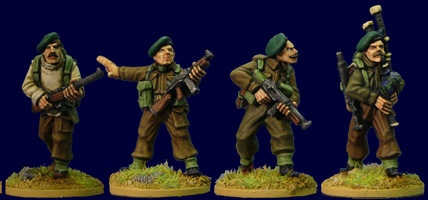 |
| Artizan Designs wonderful and characterful 28mm Lord Lovat's Commandos. I want to be absolutely sure I know what I'm doing before I put brush to these. |
Actually, neither set of painted figures is all-together wrong (though I would probably take issue with Warlord's very light coloured webbing) as the real Commandos and British Infantry, in general, changed the colour of their webbing - from Khaki to a pastel Olive Green - in about 1944. But, I have read that both types and colours of webbing co-existed in use until the end of the war.
The painting style is a different matter. Artizan's painted example figures are far more blended in a naturalistic style, as opposed to the higher contrast style of Warlord's example (and, indeed, the guide I worked from). And, while I do not have a tutorial for how they achieved this look I do have Artizan's Painting Guide, which tells me the colours they used, and I have found a rather informative painting tutorial which gives an alternative method of painting these miniatures...
I'll be studying this tutorial before I try out my next painting test and I will try out both methods on the smaller scale in order to compare them. Hopefully, my Warlord 28mm sprue will arrive today.
Tuesday, 14 February 2017
Ooops, Diversion Ahead (Bolt Action British)
Those 2017 Resolutions didn't last long...I'm back to my old easily distracted ways already!
To be fair, my recent involvement in Bolt Action games probably made it inevitable that I would want a little army of my own to play with at the club (my 1/72 Bolt Action project is for home practising/learning the rules on the kitchen table). But which?
It may sound a bit 'boring', but I fancied good old British. Though I thought I would spice things up by doing commandos. This is probably because I still have fond memories of playing with Airfix's 1/32 plastic commandos in my garden as a kid!
Now, before I start collecting a little hoard of 28mm miniatures, I thought a painting test might be in order...
By sheer coincidence, I happen to have a bag of Airfix's 1/32 British Infantry Support figures (think I bought them for the 1/32 Vickers), so these seem a convenient test figure for checking the British colour scheme...
As usual, with my Bolt Action figures, I mounted the figure on a metal base (a 25mm Repair Washer) and build up the ground with Polyfilla mixed with dome Vallejo German Camo Black Brown. In fact, I tried out Wilko's own 'Polyfilla' and that worked just as well as the real thing (but is cheaper).
Stage One - Priming and Base Coating
Next, I decided to go for a white primer as I want the colour to 'pop'...
I'm going to use Warlord Games British Infantry painting guide (available free on their website), as that is mainly based on the Vallejo Model Color paint system, which suits what I have. Though, I don't have all the paints they suggest I have near equivalents so I will have to do a bit of swapping colours around...
Colour recipe (British Infantry, mid-WW2):
Flesh base: Vallejo 804 - Beige Red
Uniform base: Vallejo 921 - English Uniform
Webbing base: Vallejo Game Color 72.061 Khaki
Helmet base: Vallejo 894 Camo Olive Green
Wood (rifle) base: Vallejo 72.043 Beastly Brown
Boots base: Vallejo Panzer Aces 306 Dark Rubber
Ground base: Vallejo 822 German Camo Black Brown
Stage Two - Applying a Shading Wash
These colours from the base of a triad of a colour system, going from a darker base to a mid-highlight, to a super highlight. However, the above base will be further 'dulled' down by the addition of an overall wash, which is designed to create shadow areas in the creases of clothing and between different material areas (outlining areas).
Warlord game suggests using Army Painter's Strong Tone Wash. Now, I've never used one of these 'quick shades' for figures, but I know lots of wargame figure painters swear by them for getting quick shading results. I looked it up (see above link) and it is rather pricey at £24.99 which I don't want to spend as it seems quite an invasive technique. Apparently, you can get a smaller bottle as an 'ink', for £2.25, which is more like an acrylic wash, so don't get the two confused.
Instead, I am looking at a Citadel product called Agrax Earthshade, which has been suggested to me as an alternative (particularly to the AP Strong Tone Ink, which from looking on YouTube looks almost identical)...
Fingers crossed - this is why you do paint tests - here we go...(I'm a bit nervous!)
As a first-time wash user, this technique seems to be something of a dark art, as you do get a bit of a fright when you first apply the liquid. The above photo shows the wash when it's still wet and as you can see there is plenty of pooling as the wash settles into any crevices in the model.
You can draw any excess wash out with your brush or a paper towel, and you can move it about a bit to more evenly distribute it across the model. I guessing that experience is needed to understand what is too much wash.
Now the awkward wait for the wash to dry completely and then we shall see how effectively it creates shadow tones in the folds of material...
It's still a bit jarring, compared to blending shadows. But, I'm determined to see this technique through to the end. Will the addition of the remaining 'triad' colours (two intensities of highlights) pull the whole thing together into a satisfying model? I hope so (but I do have a plan B, just in case).
Note: One final comment I should have added. While these sort of high contrast painting techniques are a bit unsubtle or exaggerated looking on a big 1/32nd figure, I think you have to bear in mind that they are really designed for 28mm (1/56) scale miniatures. And the effects are deliberately exaggerated so as to be seen at tabletop distance.
To be fair, my recent involvement in Bolt Action games probably made it inevitable that I would want a little army of my own to play with at the club (my 1/72 Bolt Action project is for home practising/learning the rules on the kitchen table). But which?
It may sound a bit 'boring', but I fancied good old British. Though I thought I would spice things up by doing commandos. This is probably because I still have fond memories of playing with Airfix's 1/32 plastic commandos in my garden as a kid!
Now, before I start collecting a little hoard of 28mm miniatures, I thought a painting test might be in order...
 |
| For my first attempt at painting a 'British Tommy' test figure, I'm using Warlord Games Painting Guide...It has a good list of the Vallejo paints required. |
As usual, with my Bolt Action figures, I mounted the figure on a metal base (a 25mm Repair Washer) and build up the ground with Polyfilla mixed with dome Vallejo German Camo Black Brown. In fact, I tried out Wilko's own 'Polyfilla' and that worked just as well as the real thing (but is cheaper).
Stage One - Priming and Base Coating
Next, I decided to go for a white primer as I want the colour to 'pop'...
I'm going to use Warlord Games British Infantry painting guide (available free on their website), as that is mainly based on the Vallejo Model Color paint system, which suits what I have. Though, I don't have all the paints they suggest I have near equivalents so I will have to do a bit of swapping colours around...
Colour recipe (British Infantry, mid-WW2):
Flesh base: Vallejo 804 - Beige Red
Uniform base: Vallejo 921 - English Uniform
Webbing base: Vallejo Game Color 72.061 Khaki
Helmet base: Vallejo 894 Camo Olive Green
Wood (rifle) base: Vallejo 72.043 Beastly Brown
Boots base: Vallejo Panzer Aces 306 Dark Rubber
Ground base: Vallejo 822 German Camo Black Brown
Stage Two - Applying a Shading Wash
These colours from the base of a triad of a colour system, going from a darker base to a mid-highlight, to a super highlight. However, the above base will be further 'dulled' down by the addition of an overall wash, which is designed to create shadow areas in the creases of clothing and between different material areas (outlining areas).
Warlord game suggests using Army Painter's Strong Tone Wash. Now, I've never used one of these 'quick shades' for figures, but I know lots of wargame figure painters swear by them for getting quick shading results. I looked it up (see above link) and it is rather pricey at £24.99 which I don't want to spend as it seems quite an invasive technique. Apparently, you can get a smaller bottle as an 'ink', for £2.25, which is more like an acrylic wash, so don't get the two confused.
Instead, I am looking at a Citadel product called Agrax Earthshade, which has been suggested to me as an alternative (particularly to the AP Strong Tone Ink, which from looking on YouTube looks almost identical)...
"Citadel Shades are specially formulated to flow over other paints and into the recesses on your miniatures, defining details and accentuating recesses. Once applied, they dry to provide very effective shading for your models."
Fingers crossed - this is why you do paint tests - here we go...(I'm a bit nervous!)
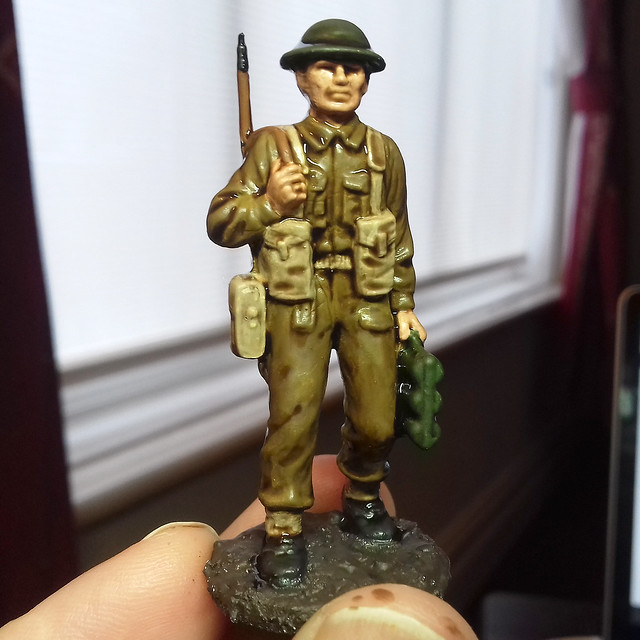 |
| The wash has, indeed, toned down the base colours a shade or two. This is why you must begin with base colours a shade lighter than what you want to end up with. |
You can draw any excess wash out with your brush or a paper towel, and you can move it about a bit to more evenly distribute it across the model. I guessing that experience is needed to understand what is too much wash.
Now the awkward wait for the wash to dry completely and then we shall see how effectively it creates shadow tones in the folds of material...
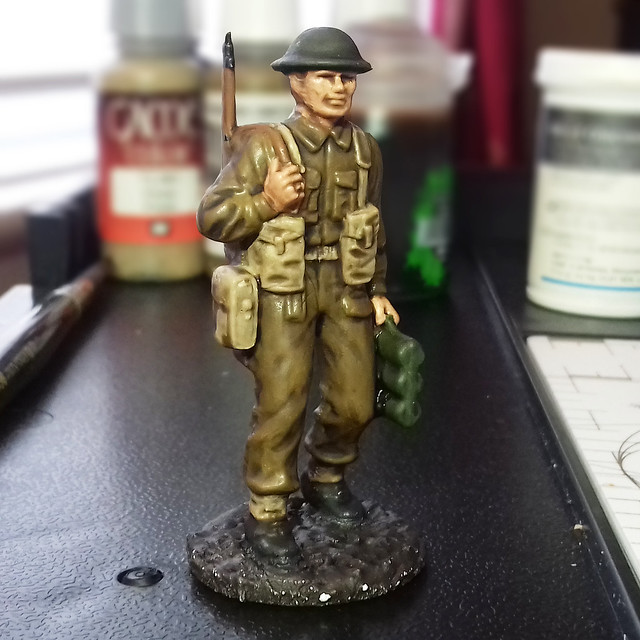 |
| Now dry, overall, it doesn't look too bad. Though, it definitely needs mid-tones and highlights to be added as it looks very flat as it is. |
Note: One final comment I should have added. While these sort of high contrast painting techniques are a bit unsubtle or exaggerated looking on a big 1/32nd figure, I think you have to bear in mind that they are really designed for 28mm (1/56) scale miniatures. And the effects are deliberately exaggerated so as to be seen at tabletop distance.
Friday, 27 January 2017
Zvezda 1/72 20mm Flak38 AA Gun - Part 3
Gun Crew Conversion
It's part of my slightly OCD-like propensity that I could not simply put up with the slight variation in size between the heads of my various Finnish AA crewmen, even when they were part of a completely different gun crew!
The Zvezda 1/72 figures, while beautifully sculpted (in my opinion), are a little on the larger side of the scale figure spectrum. Certainly, they are a smidgen larger than the usual Airfix/Revell/Ceasar plastic 1/72 figures that I have been using. So, as with my Bofors crew, I ended up feeling that I had to do a bit of corrective surgery.
In fact, one of the figures - the standing loader - ended up with his legs chopped off so I could reduce his height a little bit as well. But, the upshot of all this anality is that all my various AA crewmen look like they are in the same scale now...So, I feel better. :)
It's onto the priming now, but I will leave off painting until I assemble the last crew figures for my AA units - the Landsverk (SP AA gun) crewmen.
A feeling of trepidation ceased me at this point, as I suddenly realised that I will have to go through all this converting of figures again when I come to assemble my field artillery units. Oh, dear!
It's part of my slightly OCD-like propensity that I could not simply put up with the slight variation in size between the heads of my various Finnish AA crewmen, even when they were part of a completely different gun crew!
The Zvezda 1/72 figures, while beautifully sculpted (in my opinion), are a little on the larger side of the scale figure spectrum. Certainly, they are a smidgen larger than the usual Airfix/Revell/Ceasar plastic 1/72 figures that I have been using. So, as with my Bofors crew, I ended up feeling that I had to do a bit of corrective surgery.
 |
| Flak 38 crew, front row, left and middle figures. |
It's onto the priming now, but I will leave off painting until I assemble the last crew figures for my AA units - the Landsverk (SP AA gun) crewmen.
A feeling of trepidation ceased me at this point, as I suddenly realised that I will have to go through all this converting of figures again when I come to assemble my field artillery units. Oh, dear!
Tuesday, 24 January 2017
'Finnish' Bofors - Part 3
Crewing the gun
Under the Rapid Fire game rules that I'm using as a guide for my Finnish army collection, the Bofors AA unit needs a crew of three. The Zvezda kit does come with figures, but the WW2 pattern British Army uniform is just too difficult to modify to make passable Finns, so I'm having to look elsewhere.
In order to modify myBofors gun - to look like the Finnish variant - I purchased a couple of boxes of Zvezda's Soviet M1939 37mm AA gun (which itself is a variation of the Bofors 25mm AA gun). This set comes with a couple of Soviet crew, which will be easier to convert into Finnish soldiers (I'll probably use one of the Pegasus Soviet infantry figures I have to create a third member of the crew).
The good thing about the Zvezda gun crew figures is that they are multipart, with separate limbs (which makes it easier to pose them correctly on the gun model). So, I can swap around arms to make the Soviets fit the British Bofors properly. All I need then is some suitable heads, but I have a plan...
Under the Rapid Fire game rules that I'm using as a guide for my Finnish army collection, the Bofors AA unit needs a crew of three. The Zvezda kit does come with figures, but the WW2 pattern British Army uniform is just too difficult to modify to make passable Finns, so I'm having to look elsewhere.
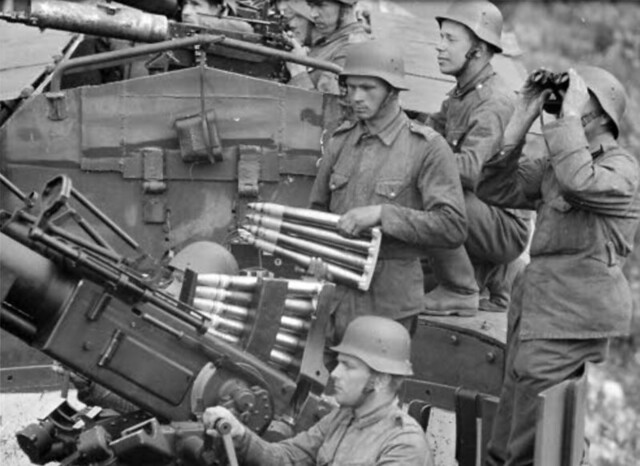 |
| Finnish Bofors crew in 1941, mostly wearing German M40 helmets. Though, it seems they were still in short supply as the foremost crewman needs a bigger size! |
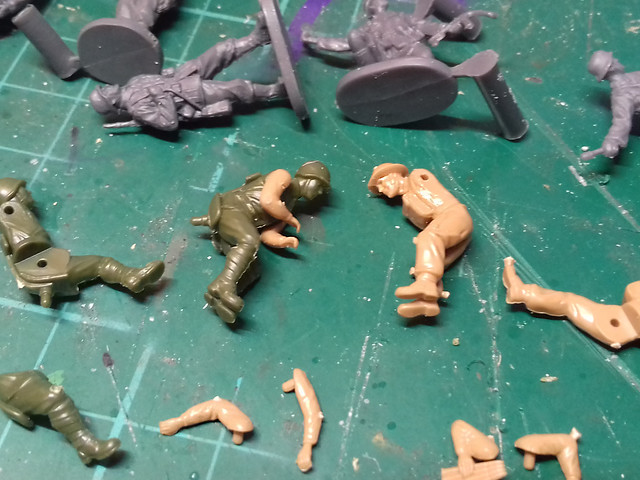 |
| One of the Soviet AA gun crew fitted with the arms from the British Bofors crew. |
I am going to try out some of Ceaser Model's mid-WW2 German infantry as noggin-doners. The Finns use the German M40 coal-scuttle ('Stahlhelme') helmet as standard during the Continuation War, so I will have to do some brutal transplant surgery.
There was a slight difference in scale between the Zvezda and the Ceasar figures, the Ceasar heads being a bit small for the bodies I grafted them onto. But I'm hoping this will not be so noticeable as they are in a sitting pose...
Well, they are a bit of a hack job, but they will have to do. Now, onto the painting, though, I may wait a while until I'm ready to paint a batch of Finnish figures (I have a few drivers in the works).
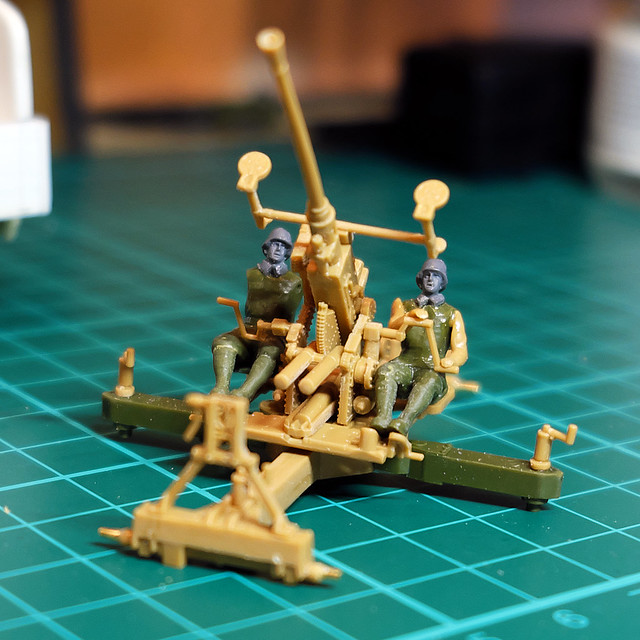 |
| Figures with the new heads. Just trial fitting positions for the fitting of arms. |
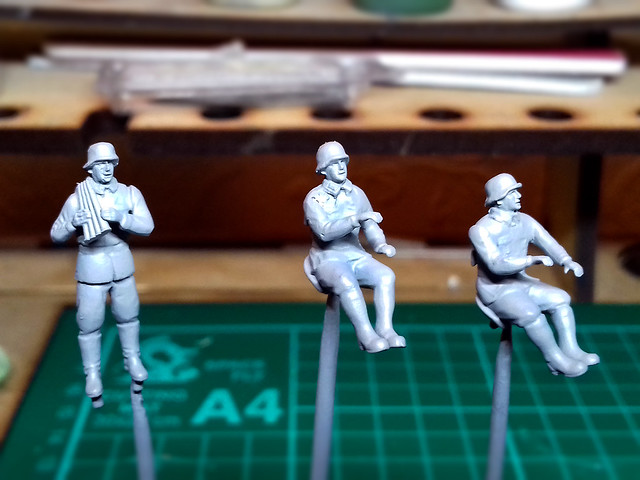 |
| Dr, Frankenstein would be proud! :) |
Tuesday, 24 November 2015
Driving me mad!
I think I mentioned my surprise that so many model trucks come without driver figures? I know I have done a few resin conversions but even so I am getting a bit fed up scrambling about for figures I can use as drivers.
And so...I had a look around the tin'ternet and I was surprised there weren't more generic driver figure sets in 1/72. And what I did find were quite pricey. But I eventually scored a 'hit' with Google and found some reasonably priced white metal figures at Sands Models...
As I am in the wife's good books at the moment I went ahead and ordered them (despite being slightly over budget this month already). They are priced individually at 50p each, and for that you get a body with a choice of head. I went for 10 male figures with bare heads (there are a variety of heads with different hats and helmets available).
A nice touch is the inclusion of a number of steering wheels, very handy. Some of the models need a hair cut, unless I got some of the female heads that Sands Models also do by accident!
The bodies are a nice mix. These include torsos with integral steering wheel and some without. Again this is a very nice option as sometimes the cabs are a very tight fit, or the model might come with it's own steering wheel fitted.
Obviously, it's very hard to get a fair idea of the quality of these figures as white metal does not photograph well. But you get what you pay for, these aren't highly detailed, finely sculpted resin display quality scults - they are, however very useful scale figures at a very reasonable price. Ideal for me as I have a lot of vehicles without drivers.
It will be interesting to see one of these painted up, and I will be doing that soon as I have another truck kit in the cue for my workbench whish doesn't come with one included.
Link to Sands Models Generic Driver Figure.
And so...I had a look around the tin'ternet and I was surprised there weren't more generic driver figure sets in 1/72. And what I did find were quite pricey. But I eventually scored a 'hit' with Google and found some reasonably priced white metal figures at Sands Models...
As I am in the wife's good books at the moment I went ahead and ordered them (despite being slightly over budget this month already). They are priced individually at 50p each, and for that you get a body with a choice of head. I went for 10 male figures with bare heads (there are a variety of heads with different hats and helmets available).
A nice touch is the inclusion of a number of steering wheels, very handy. Some of the models need a hair cut, unless I got some of the female heads that Sands Models also do by accident!
The bodies are a nice mix. These include torsos with integral steering wheel and some without. Again this is a very nice option as sometimes the cabs are a very tight fit, or the model might come with it's own steering wheel fitted.
Obviously, it's very hard to get a fair idea of the quality of these figures as white metal does not photograph well. But you get what you pay for, these aren't highly detailed, finely sculpted resin display quality scults - they are, however very useful scale figures at a very reasonable price. Ideal for me as I have a lot of vehicles without drivers.
It will be interesting to see one of these painted up, and I will be doing that soon as I have another truck kit in the cue for my workbench whish doesn't come with one included.
Link to Sands Models Generic Driver Figure.
Friday, 1 May 2015
1/72 RAF Tomahawk IIA Diorama - Part 1
As my Airfix Tomahawk and 'Tilly' utility vehicle models near completion my attention turns to the diorama I plan to make for them. My idea was to create a pretty simple - and small - airfield scene with the 26 (recce) Squadron Tomahawk being serviced by ground crew...Which begged the question, where do I get the 1/72 RAF ground crew figures from?
Annoyingly the Airfix 'Tilly' vehicle doesn't come with any crew - not even a driver. So I had to start from scratch - luckily Airfix makes it's own 1/72 'WWII RAF Personnel' figure set (which explains why their vehicles don't come with a crew - they want you to buy this set).
I did look around for alternatives and there are some individual white metal figures and some very plastic expensive Czech 3-figure sets, but neither were right for me. Revell, on the other hand, do a very nice hard plastic set, similar to the Airfix one in theme, but it focuses more on the pilots than it does the ground crew.
Left: One of the optional figure sets I looked at was some lovely figure models by the Czech Master company. But at £8.50 for just 3 figures this was a bit too expensive for me. The photo shown is, however, two of their excellent WAAFs, which would make terrific subjects for a diorama.
To be honest I would have preferred to have used the Revell set, aside from being he right price and the right number and variety of figures it was also made in hard plastic. The Airfix set is the same soft plastic they use for their other 1/72 military figure sets. Catch 22 - but in the end it was ground crew I was after and the Airfix set had a greater variety (if you need pilots, however, do try the Revell set).
 |
| The Airfix 'WWII RAF Personnel' set has great variety of ground crew in a number of poses. |
 |
| Despite it's issues the Airfix set does contain some very nicely posed figures. The detail and sculpting is very lifelike - if somewhat stiff - and so it's worth persevering with. |
Now, the reason I prefer to avoid soft plastic figures is because they can be a nightmare to 'clean up'. Even the better quality ones - and the Airfix figures counts among these - suffer from a varying degree of flash and moulding seams. Trimming off this extraneous plastic is a bit of a pain as you cannot simply sand soft plastic parts smooth.
Soft plastic tends to 'fray' if sanded or filed, so any superflous plastic left over from the moulding process has to be very carefully shaved off with your sharpest craft-knife blade. But even then seam-lines can be left behind so the problem becomes one of how to get rid of these pesky blemishes.
I have decided to experiment with heat. Either by using a heated needle or by using liquid poly cement I hope to carefully melt the soft plastic and so smooth out and seams and plastic remnants.
Next: I pick my crew and experiment with different ways to get rid of soft plastic flash.
Useful links:
- Plastic Soldier Review: Airfix, Set 0174 - R.A.F. Personnel
- Plastic Soldier Review: Revell, Set 02401 - Pilots and Ground Crew: Royal Air Force
Subscribe to:
Posts (Atom)
